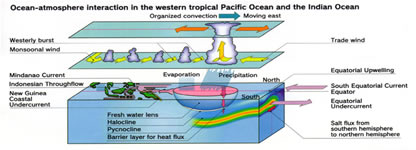Scientific objectives in the western Pacific Ocean
The surface layer in the western tropical Pacific ocean is characterized with some of the highest sea surface temperature (SST) among the world oceans, and it drives the global atmosphere with active convection. The surface water, for which the annual mean sea surface temperature is over 28-29 deg-C from 15S to15N west of the date-line, is called the warm pool. The warm pool migrates seasonally from 20N to 20S in summer in the northern and southern hemisphere. It is usually found to the west of the dateline, and it extends to the dateline during westerly winds in boreal winter and spring (Philander, 1990). In the central and eastern Pacific the cold tongue, with low SST due to equatorial upwelling under the easterly trade winds, intrudes into the warm pool. The boundary between the warm pool and the cold tongue is located near the dateline. The equatorial upwelling is well developed during boreal summer and winter, and is less obvious during spring when the trade winds are weakened.
As a major interannual variation, the warm pool migrates from the central Pacific to the eastern boundary of the Pacific Ocean along the equator during an El Nino. On the other hand , during a La Nina, the warm pool stays to the west of the dateline(Philander, 1990; Kuroda and McPhaden, 1993; Picaut et al., 1997). Thus, the warm pool may play an important role in ENSO development and in interannual ocean and atmosphere variations. The air-sea interaction in the western tropical Pacific is summarized in Fig. 1.

Figure 1 Schematic diagram of air-sea interaction in the western tropical Pacific Ocean.
Generally, SST is governed by surface heat flux, upwelling (vertical mixing) and horizontal advection of warm water or cold water. The warm isothermal surface layer of the tropical ocean is well separated from the cold water in the thermocline layer. The thickness of this isothermal layer is determined by the basin scale oceanic response to the surface winds. In the west, the thermocline is deep and warm water is piled up in the western Pacific due to the trade winds. In the east, the trade winds keep SST low due to a combination of the shallow thermocline and equatorial upwelling. During such a normal period, the eastward pressure gradient at the sea surface is balanced with the surface wind stress. When an El Nino occurs, the migration of the warm water from west to east takes place on a basin scale. The thick isothermal layer in the western Pacific shallows, and the SST in the eastern Pacific rises because the thermocline is deepened and the upwelling is suppressed. The subsurface temperature data from the TAO array brought the great improvement in ENSO prediction capability by successfully monitoring this process through end of the TOGA decade (McPhaden et al, 1998).
The active convection associated with high SST causes heavy rainfall, over 5000 mm/year (Tayler, 1973), and produces a shallow low salinity layer with a sharp halocline in the western Pacific warm pool. The shallow low salinity mixed layer prevents vertical mixing and allows a rise in SST. The layer within the deep isotherm layer and below the shallow mixed layer is called the barrier layer, because it suppresses the entrainment of cold water from the subsurface layer to the surface layer (Lukas and Lindstrom, 1991). The barrier layer changes greatly an ENSO time scales, as it becomes thick in the central and the eastern Pacific and thin in the western Pacific during El Nino. It becomes thick in the central and western Pacific during a normal period, and is particularly well developed during La Nina. Since the generation of the thick barrier layer in the central and eastern Pacific precedes the increase in surface layer temperature, the barrier layer plays an important role in the rise of SST (Ando and McPhaden, 1997).
The high SST activates the convection which induces more freshwater. Through the positive feedback of this hydrological cycle, salinity is a key factor, as well as temperature, in controlling the air-sea interaction. To further elucidate this mechanism, the most important requirement at the beginning of the TRITON buoy development was to measure heat and fresh water flux at the surface, and subsurface salinity.
The scientific goal of the TRITON buoy program is to elucidate the generation and dissipation mechanisms of the warm pool. For that purpose the following studies will be addressed:
・ Warm and fresh water accumulation processes near the equator during westerly bursts;
・ Heat and salt (fresh water) transport taking account low latitude western boundary currents;
・ Barrier layer development on various space and time scales;
・ Seasonal and interannual variability and dynamics of equatorial currents; and
・ Coupling process of the ocean and atmosphere, including the hydrological cycle, with particular focus on MJO (Madden Julian Oscillation: intra-seasonal oscillation).
